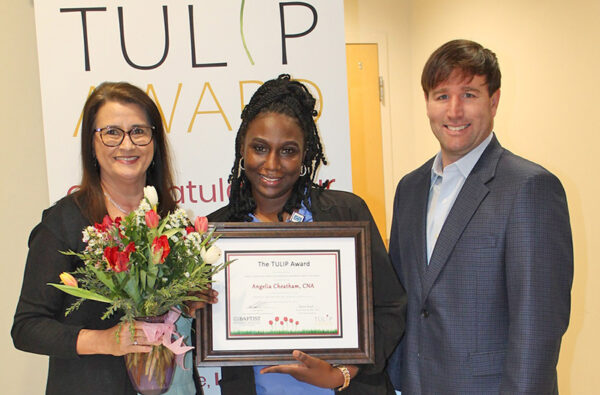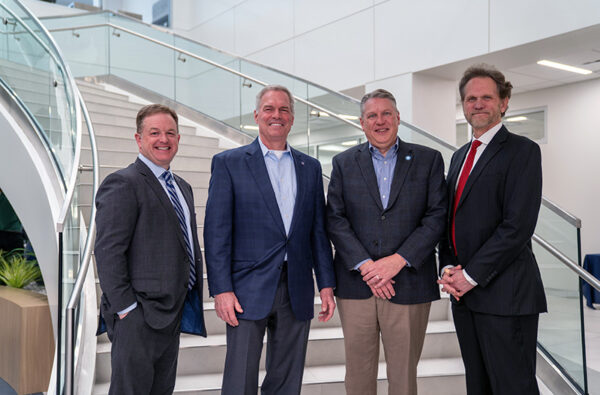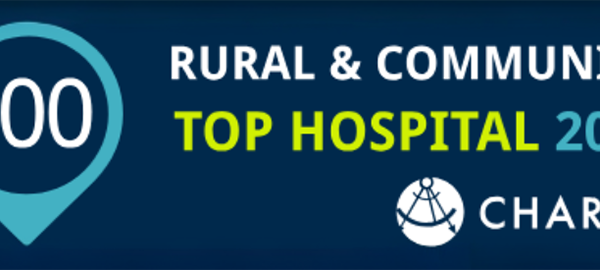It’s clear that active shooter situations unfortunately unfold in a variety of settings, including in health care and educational facilities, so it’s important that everyone is prepared with training on how to deal with an active shooter. Baptist security teams and leadership work diligently to protect us and mitigate threats, but active shooters are unpredictable, so it’s crucial to have a plan for what you would do should the situation occur.
We discussed active shooters and training with Michael Rallings, system director of security. Since joining Baptist earlier this year, Rallings has been examining the entire system to help bring about more standardization in operations and training policy. He’s a support system for security leaders, and a liaison with law enforcement in Tennessee, Mississippi and Arkansas.
We were also joined by James Polk, director of security at Baptist North Mississippi, who brings with him nearly two decades of service to Baptist in security and safety.
How is Baptist working to help protect employees from active shooters?
Michael Rallings:
Aligning with guidelines from The Joint Commission, we practice prevention, protection, mitigation, response and recovery.
With prevention, we’re reminding team members that this could happen to them. We’ve seen it happen everywhere – in health care facilities, churches, synagogues and malls. Sadly, no places are immune to an active shooter situation.
We’re making sure that we promote awareness and provide training and education. We complete drills and work with our security leaders across the system to make sure that each facility, each entity, conducts its own planning and training. We are not limited to just the hospitals but are also concerned about our clinics, offices and Baptist Health Sciences University. We want to touch everyone in the entire system on the protection and awareness side.
Protection also means access control, such as ensuring employees wear their IDs and are greeting people who are wandering around the building to see if they have access to controlled areas, need guidance, direction or an escort. We also limit access with locked doors or barriers when appropriate.
We actively focus on mitigating any threats to patients, visitors and employees. Our security professionals across the system work with Human Resources and leadership to investigate and coordinate with law enforcement and Emergency Management to mitigate threats. Most importantly, we talk about the situation and follow up to improve our response.
We work with leadership to make sure that we’re doing everything we can do to mitigate a potentially violent situation or reduce a hazard that’s been identified. For example, we will intervene when we see potentially concerning behaviors from an employee, visitor or patient. We take it seriously and we act when necessary. We don’t assume things are going to be OK. We also focus on making sure that we have the capability to reduce loss of life by lessening the impact of an active shooter situation.
For response, we’re teaching employees how to respond, and our training is part of that. With recovery, Baptist would provide employees with services to help them recover from a traumatic situation.
What should individuals who get caught in an active shooter situation do?
Michael Rallings:
We’ve adopted the Run, Hide, Fight Active Shooter Response, as recommended by the FBI and Department of Homeland Security.
Seconds count! Many people will deny that they’re hearing gunshots, or they’ll deny that something is going on, and say, “Well, yeah, that sounded like fireworks to me.” Nobody should be popping fireworks in a hospital or office anyway, so let’s assume that it’s something very bad and get to safety.
Run
Have an escape route and plan in mind. Know where your exits are located, and follow these guidelines:
- Leave your belongings behind.
- Help others escape, if possible.
- Evacuate regardless of others who choose to hide.
- Warn/prevent individuals from entering.
- Do not attempt to move wounded people.
- Keep your hands visible.
- Follow police instructions.
- Call 911 when safe.
If you have mobility issues and can’t run or you’re caring for an immobile patient, practice avoidance/hiding instead.
Hide
Your hiding spot should:
- Be out of the active shooter’s view
- Provide protection if shots are fired
- Not restrict options for movement
Keep yourself safe while hiding by silencing electronics and locking doors, securing them with available furniture or equipment.
Provide law enforcement or 911 operators with:
- Location of the shooter
- Number of shooters
- Physical description of shooters
- Number and types of weapons
- Number of potential victims
Fight
As an absolute last resort:
- Act as aggressively as possible.
- Throw items and use improvised weapons, such as a fire extinguisher.
- Work together to incapacitate the shooter.
- Commit to your actions.
James Polk:
The nursing staff or other health care workers often ask what to do if this situation arises. I’ve developed this training video to give them some instructions and different scenarios to think about.
They also receive hands-on training with presentations in real time. Health care workers are welcoming the presentations. With all the recent active shooter events across the country, this has been a revelation for all. Staff members are definitely showing an interest in knowing what actions to take during this type of event.
How often does Baptist conduct training exercises?
James Polk:
An active shooter training module is part of our annual HealthStream mandatory training in July. Also, we conduct drills throughout the year. We are required by The Joint Commission to perform two live drills per year. This doesn’t mean that the two drills have to be affiliated with an active shooter. We attempt to perform drills on any emergency or life-threatening incident, such as responses to inclement weather or fire.
Michael Rallings:
For the drills, each entity coordinates with local law enforcement and Emergency Management. For example, Memphis police won’t respond to Oxford or other regional communities. It will be a local response. So, James is making sure that he coordinates with Oxford Police and Oxford Fire. Our friends in Jackson coordinate with Jackson Police and Jackson Fire. At NEA in Jonesboro, they coordinate with local police and fire.
It’s important to work with first responders and officials to plan, mitigate, drill, to make sure we have practiced our response and we know how to exercise the plan. When you practice the plan, you’re better able to respond.
Anything you’d like to add?
Michael Rallings:
We want our employees to be proactive. There is an enormous amount of training sponsored by the Department of Homeland Security, the active shooter HealthStream module and the video from James Polk. Spend a few minutes watching the video, then go back to your work area and walk through some of those steps.
Find your emergency exits and know the best way to get to them. Where are the lockable rooms? How do you barricade a door? What things can you pick up in your work environment that could be used as a weapon if you have no choice but to fight the assailant? Acknowledge that this could happen.
There are other proactive measures. If you see someone wandering around our facilities without being addressed by anyone, ask them if you can help them. Don’t allow access to unauthorized areas and avoid propping open doors that are supposed to be closed. And if you see something, say something. Call Security, your manager or local law enforcement.
Additional Resources
Active Shooter Resources – FBI
Active Shooter Preparedness – TN.gov






